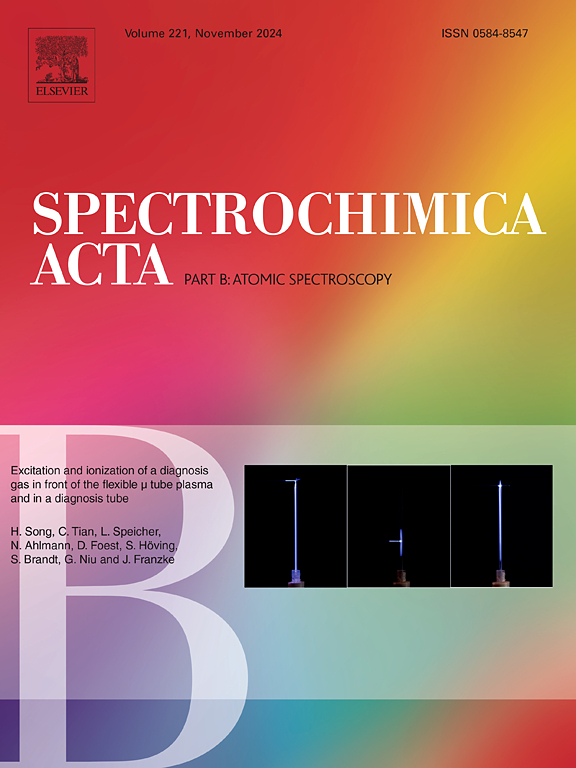Acoustic signal in overcoming the matrix effect in LIBS: Toward reliable applicability
IF 3.8
2区 化学
Q1 SPECTROSCOPY
引用次数: 0
Abstract
The versatility of laser-induced breakdown spectroscopy (LIBS) resulting from its advantageous analytical characteristics is, unfortunately, still limited by challenges inherent to the fundamental principles of the method – the processes of laser ablation and laser-induced plasma generation. Unwanted effects (generally known as matrix effects) significantly decrease the analytical performance of LIBS, complicating quantification and impairing reproducibility.
This study investigates acoustic signals accompanying plasmas (LIPAc) to overcome these limitations and enhance LIBS performance. The influence of instrumental (microphone types), operational (laser wavelength and fluence) and sample parameters on acoustic responses were evaluated. The results indicate that laser fluence strongly influences acoustic wave oscillation. When laser fluence substantially exceeds the breakdown thresholds of the different components in the matter, acoustic responses may become identical across various materials. On the other hand, proportionality in differences of acoustic signal is maintained for different microphones and laser wavelength settings.
Promising solutions for eliminating matrix effects on various surfaces were identified, but the suitability and efficiency may be highly dependent on the emission line used. This is demonstrated using the signals of atomic Cu(I) 324.74 nm and ionic Cu(II) 329.04 nm lines measured from an aluminum sample with a partially coppered and partially roughened surface.
Acoustic maps of a galena ore sample demonstrate the applications of LIPAc in spatially resolved LIBS imaging and elemental mapping. These maps can help eliminate the discrepancy between the intensities of the calcium atomic line of Ca(I) at 422.67 nm measured from the galena mineral and calcium carbonate.

声信号在LIBS中克服矩阵效应:走向可靠的适用性
激光诱导击穿光谱(LIBS)由于其有利的分析特性而具有多功能性,不幸的是,它仍然受到该方法基本原理固有的挑战的限制-激光烧蚀和激光诱导等离子体产生的过程。不需要的效应(通常称为基质效应)显著降低LIBS的分析性能,使定量复杂化并损害再现性。本研究研究了伴随等离子体的声信号(LIPAc),以克服这些限制并提高LIBS的性能。评估了仪器(麦克风类型)、操作(激光波长和影响)和样品参数对声学响应的影响。结果表明,激光通量对声波振荡有强烈的影响。当激光通量大大超过物质中不同组分的击穿阈值时,声学响应可能在不同材料之间变得相同。另一方面,对于不同的传声器和激光波长设置,声信号的差异保持成比例。确定了消除各种表面上的基体效应的有希望的解决方案,但适用性和效率可能高度依赖于所使用的发射线。这是用原子Cu(I) 324.74 nm和离子Cu(II) 329.04 nm线的信号来证明的,这些线是从部分镀铜和部分粗糙表面的铝样品中测量的。方铅矿样品的声学图展示了LIPAc在空间分辨LIBS成像和元素制图中的应用。这些图谱有助于消除方铅矿和碳酸钙在422.67 nm处测得的Ca(I)钙原子线强度之间的差异。
本文章由计算机程序翻译,如有差异,请以英文原文为准。
求助全文
约1分钟内获得全文
求助全文
来源期刊
CiteScore
6.10
自引率
12.10%
发文量
173
审稿时长
81 days
期刊介绍:
Spectrochimica Acta Part B: Atomic Spectroscopy, is intended for the rapid publication of both original work and reviews in the following fields:
Atomic Emission (AES), Atomic Absorption (AAS) and Atomic Fluorescence (AFS) spectroscopy;
Mass Spectrometry (MS) for inorganic analysis covering Spark Source (SS-MS), Inductively Coupled Plasma (ICP-MS), Glow Discharge (GD-MS), and Secondary Ion Mass Spectrometry (SIMS).
Laser induced atomic spectroscopy for inorganic analysis, including non-linear optical laser spectroscopy, covering Laser Enhanced Ionization (LEI), Laser Induced Fluorescence (LIF), Resonance Ionization Spectroscopy (RIS) and Resonance Ionization Mass Spectrometry (RIMS); Laser Induced Breakdown Spectroscopy (LIBS); Cavity Ringdown Spectroscopy (CRDS), Laser Ablation Inductively Coupled Plasma Atomic Emission Spectroscopy (LA-ICP-AES) and Laser Ablation Inductively Coupled Plasma Mass Spectrometry (LA-ICP-MS).
X-ray spectrometry, X-ray Optics and Microanalysis, including X-ray fluorescence spectrometry (XRF) and related techniques, in particular Total-reflection X-ray Fluorescence Spectrometry (TXRF), and Synchrotron Radiation-excited Total reflection XRF (SR-TXRF).
Manuscripts dealing with (i) fundamentals, (ii) methodology development, (iii)instrumentation, and (iv) applications, can be submitted for publication.

 求助内容:
求助内容: 应助结果提醒方式:
应助结果提醒方式:


